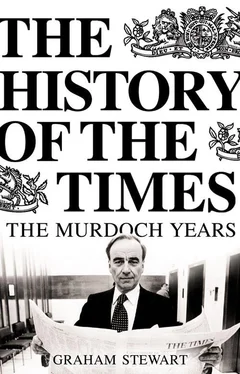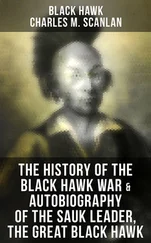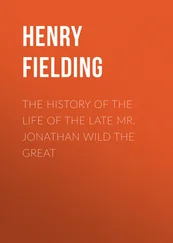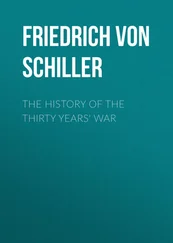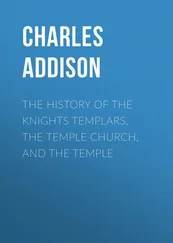In fact, there was nothing in Murdoch’s negotiating stance that suggested this ethically doubtful option formed any part of his strategy. Indeed, the more Hamilton and the Times Newspapers directors contemplated the ‘ruthless operator’ the more they believed he had ‘a personality which probably could relate to The Times ’. [58] Denis Hamilton to Directors of TNHL, 16 January 1981. Hamilton Papers.
Rees-Mogg was now firmly of the view that Murdoch, rather than his own consortium, was the newspaper’s saviour-in-waiting. All that remained was for an appropriate price to be agreed together with his assent to a number of safeguards that would stop him interfering in the paper’s editorial content in the way in which he was known to do with the Sun .
The negotiations came to a head on 21 January at the elegant Thomson headquarters in Stratford Place, off Oxford Street. The Thomson team refused Murdoch’s demand that they should give a written guarantee that the company’s assets were worth £17.9 million and that the current losses would be no greater than £14.5 million. There was, Brunton later admitted, ‘some blood on the walls’. Murdoch then went downstairs to face the vetting committee that had been drawn up to assess his personal suitability. ‘These dignified gentlemen probably thought I was quaking with fear,’ he recalled; ‘actually I was shaking with anger’. [59] Quoted in the Sunday Times , 15 February 1981.
Despite this, he made a favourable impression. The vetting committee consisted of Sir Denis Hamilton together with the two editors, Rees-Mogg and Harold Evans, and the national directors, Lords Roll, Dacre, Greene and Astor (Lord Robens, who was in America, kept in touch by telephone). Murdoch made several assurances: that he would abide by the editorial safeguards drawn up and would not seek to direct editors, even when they pursued views contrary to those expressed in his other titles; that he hoped Harold Evans would continue to edit the Sunday Times ; that he did not have the resources of Lord Thomson at his disposal. He said that he saw the role of the independent national directors as that of a court of appeal for an editor who felt himself in conflict with his proprietor. Murdoch guaranteed to increase the number of independent directors sitting on the board of Times Newspapers Holdings Ltd. This board alone would have the power to appoint or remove an editor, voting by majority decision. It would also take a majority vote of the directors to approve any subsequent sale of The Times or Sunday Times . [60] Minutes of the TNL Editorial Vetting Committee, 21 January 1981, file A759–9335.
Harold Evans took great care to ensure the wording of the guarantees. Rees-Mogg took a less legalistic view, believing that, once ensconced, the power of a proprietor was such that little could realistically be done to bind him to guarantees he had chosen, for whatever reason, to disobey. Rees-Mogg maintained, ‘I thought therefore a judgment of character had to be made’, and in his opinion Murdoch ‘would in fact honour the agreements’. Thus the precise wording was not really crucial. [61] William Rees-Mogg to the author, interview, 3 December 2001.
The Spectator ’s press columnist later took a yet more robust view, maintaining that The Times would never have seen the light of day if John Walter, the ex-bankrupt who founded it in 1785 with the intention of making money for himself, had been subjected to the proprietorial guarantees forced upon Murdoch. [62] Paul Johnson, Spectator , 20 April 1985.
In fact, the Australian was in some respects treated with less condescension than had been Roy Thomson. When he had bought The Times in 1966 he had to agree not only to abstain from editorial interference (which was, in any case, never his style) but also that he would not even sit on the newspaper’s board (from where, with de haut en bas condescension and despite having sold the business, Gavin Astor managed to ensure his appointments continued to exercise a guardian role). Murdoch fully intended to sit on the board of his own company into which he would be pouring money.
The vetting committee voted unanimously in favour of Murdoch. The deal was eventually done after the midnight hour had struck. Subject to securing agreement for job cuts with the unions and that the Government would not refer the purchase to the Monopolies and Mergers Commission, The Times and the other TNL titles would become the property of News International. The press releases went out on 22 January. Brunton expressed the hope that the unions would agree with him that Murdoch represented the best hope of keeping TNL together. Murdoch sought to concentrate on the guarantees he had given with regard to independent national directors, to his faith in Harold Evans as ‘one of the world’s great editors’ and to his own intentions:
I am not seeking to acquire these papers in order to change them into something entirely different. I have operated and launched newspapers all over the world. This new undertaking I regard as the most exciting challenge of my life. [63] Statements by Sir Gordon Brunton and Rupert Murdoch, press releases, 22 January 1981, Hamilton Papers A759–9335.
The first major newspaper to carry the news was Rothermere’s London Evening Standard . The banner headline roared out ‘MURDOCH BUYS THE THUNDERER’. [64] Evening Standard , 22 January 1981.
Thomson’s asking price for Times Newspapers was £55 million. Murdoch’s final offer of £12 million was £8 million less than the bid Rothermere had made and £13 million less than Rothermere had proffered for the Sunday Times alone. That Brunton nonetheless favoured Murdoch’s bid was proof that Thomson was philanthropically more interested in the long-term future of The Times than in making money from its sale.
What remained to be seen was whether Murdoch was equally highminded. True, TNL was making a loss, but such losses could be set against the tax payable on the profits of News International’s other press division, News Group Newspapers (the Sun and the News of the World ). NGN had recorded a £20.3 million pre-tax profit in the second half of 1980. In return for the £12 million Murdoch had paid for TNL, he had gained the freehold of the Sunday Times building on Gray’s Inn Road (said to be worth at least £8 million) together with other assets such as vehicles and machinery that were roughly computed to be worth nearly £18 million. Of the £12 million paid to Thomson, £8 million was for the Gray’s Inn Road property and only £4 million for the shares in Times Newspapers. By keeping the property assets of TNL separate from the publishing subsidiary, News International could shut down the papers with minimal redundancy payouts to the employees and yet liquidate the property assets separately. [65] Sunday Times , 15 February 1981; Daily Telegraph , 29 September 1981.
Brunton believed Murdoch was a man of his word. If he was not, Thomson had sold out to someone who could make a quick profit as an asset stripper.
Murdoch’s purchase of Times Newspapers was conditional. If he could not negotiate sufficient job cuts with the unions before 15 March the deal would be off. In this eventuality, the Thomson board would find themselves scrapping around at the last minute for an alternative purchaser in whatever days remained before the official shut-down of the company. In that eventuality it would be a buyer’s market and the papers might have to be sold to a proprietor who fell short of Brunton’s ideals (although he remained adamant that he would rather see The Times put to sleep than handed into the bear hug of Robert Maxwell). [66] Sir Gordon Brunton to the author, interview, 8 April 2003.
There was also a second hurdle. Newspaper takeovers were subject to referral to the Monopolies and Mergers Commission. Purchasing TNL gave News International more than a quarter of the market share in dailies. The Government might block the purchase on these grounds alone. At any rate, there was no prospect of the Monopolies Commission issuing its report before the 15 March deadline for transferral of ownership.
Читать дальше
